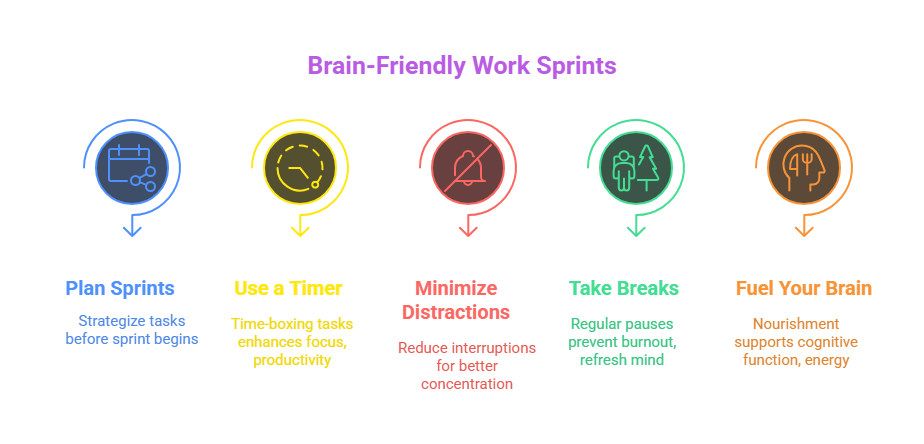Brain-Friendly Work Sprints: Productivity Without Burnout

Introduction: Work Smarter, Not Harder
Ever feel like you’re sprinting through work but still burning out? You’re not alone! Brain-friendly work sprints are the secret to staying productive without crashing. I used to grind for hours, thinking more time meant more output—until my brain waved a white flag.
This article shares seven science-backed ways to master work sprints for focus and unlock brain-friendly productivity. Ready to learn how to work smarter? Check out our 5-Minute Habits That Can Change Your Day for quick productivity wins!
Let’s dive into brain-friendly work sprints and keep burnout at bay!

1. Work Sprints for Focus: The Power of Short Bursts
Why do work sprints for focus work? Your brain loves short, intense bursts over endless marathons. I used to slog through tasks for hours, but my focus tanked. Science says we’re wired for cycles—think 25-minute sprints.
A study found simultaneous tasks reduce efficiency (Pashler, 1994). Brain-friendly work sprints keep you sharp by focusing on one task at a time. That’s how to work smarter!
My sprints are my brain’s best friend!
Tip: Set a 25-minute timer for one task, no distractions.
2. Plan Your Sprints Like a Pro
Good brain-friendly work sprints start with a plan. I used to dive into tasks randomly, but that’s a burnout trap. A quick plan keeps you on track for brain-friendly productivity.
List your top three tasks each morning and assign sprint times. This sets you up for work sprints for focus and teaches you how to work smarter. No more chaotic days!
My plan is my productivity GPS!
Tip: Pick three tasks and assign 25-minute sprints daily.
3. Use a Timer (Your Brain Will Thank You)
Timers are the backbone of brain-friendly work sprints. I used to think I could “feel” time—spoiler: I couldn’t. A timer keeps you honest and boosts work sprints for focus.
Try the Pomodoro technique: 25 minutes on, 5 minutes off. It’s a game-changer for brain-friendly productivity and shows how to work smarter. Your focus will soar!
My timer is my sprint coach!
Tip: Use a Pomodoro app for 25-minute sprints.
4. Minimize Distractions for Peak Focus
Distractions kill brain-friendly work sprints. My phone used to buzz like a beehive, yanking me from focus. Sound familiar?
Research shows interruptions harm performance (Bailey & Konstan, 2006). Mute apps during sprints to nail work sprints for focus. That’s how to work smarter with brain-friendly productivity.
My silent phone is my focus hero!
Tip: Mute non-essential apps for 25 minutes.
5. Take Brain Breaks to Recharge
Breaks are non-negotiable for brain-friendly work sprints. I used to power through without pausing—big mistake. My brain felt like mush.
Short breaks boost mental recovery (Kühnel & Sonnentag, 2011). Step away, stretch, or pet your cat. This fuels work sprints for focus and shows how to work smarter.
My breaks keep burnout away!
Tip: Take a 5-minute break after each 25-minute sprint.
6. Fuel Your Brain with Smart Habits
Your brain needs fuel for brain-friendly work sprints. I used to skip water and snacks, thinking I was “saving time.” Nope—my energy crashed.
Stay hydrated, eat light snacks, and get enough sleep. These habits power work sprints for focus and unlock brain-friendly productivity. It’s how to work smarter!
My water bottle is my productivity sidekick!
Tip: Keep water and a healthy snack nearby during sprints.
7. Reflect and Tweak Your Sprints
Mastering brain-friendly work sprints takes tweaking. I used to stick to one routine, but reflecting helped me improve. What works for you?
At day’s end, jot down what clicked or flopped. This sharpens work sprints for focus and boosts brain-friendly productivity. That’s how to work smarter!
My tweaks make me a sprint pro!
Tip: Spend 2 minutes daily noting what improved your sprints.
Table: Work Sprints vs Continuous Work
| Aspect | Work Sprints | Continuous Work |
|---|---|---|
| Focus | High, short bursts | Low, scattered |
| Energy | Sustained with breaks | Drained, burnout risk |
| Output | Quality, efficient | Lower, error-prone |
| Stress | Low, manageable | High, overwhelming |
This table shows why work sprints for focus beat grinding!
Infographic: 5 Tips for Brain-Friendly Work Sprints
Want a quick guide to brain-friendly work sprints? This infographic, made with Napkin AI, sums up how to work smarter without burnout.

Tips: Plan sprints, use a timer, minimize distractions, take breaks, fuel your brain.
Quote to Keep You Sprinting
“Work hard in bursts, rest well in peace.” — Anonymous
This nails brain-friendly productivity for me!
Why Work Sprints Work
Brain-friendly work sprints aren’t just hacks—they’re science-backed. Focused bursts reduce task interference (Pashler, 1994). I felt the difference when I switched from grinding to sprinting. You’ll master work sprints for focus and how to work smarter!
My sprints are my anti-burnout shield!
Conclusion: Sprint Your Way to Productivity
You’ve got seven ways to nail brain-friendly work sprints. From timers to breaks, these tips boost work sprints for focus and deliver brain-friendly productivity. Start tomorrow with one sprint—maybe a 25-minute focus block. What’s your go-to tip for how to work smarter? Share in the comments!
For more productivity hacks, check out 5-Minute Habits That Can Change Your Day. “Sprint smart, win big!” — Me, after mastering brain-friendly work sprints!
Resources & Useful Links
- Bailey, B. P., & Konstan, J. A. (2006). On the need for attention-aware systems: Measuring effects of interruption on task performance.
Computers in Human Behavior, 22(4), 685–708.
https://doi.org/10.1016/j.chb.2005.12.009 - Kühnel, J., & Sonnentag, S. (2011). How long do you benefit from vacation? A closer look at the fade-out of vacation effects.
Journal of Organizational Behavior, 32(1), 125–143.
https://doi.org/10.1002/job.699 - Pashler, H. (1994). Dual-task interference in simple tasks: Data and theory.
Psychological Bulletin, 116(2), 220–244.
https://doi.org/10.1037/0033-2909.116.2.220



